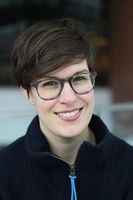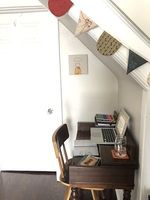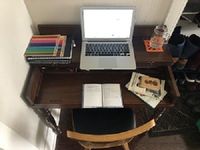At the Desk: Claire Caldwell
Toronto poet Claire Caldwell's new collection, Gold Rush (Invisible Publishing), is a study of the various ways women can be considered settlers in their own time, and what effect that presence has had on themselves, each other, and the natural environments they inhabit.
Flying all the way from the Klondike to the vast, unknowable expanse of outer space (and hitting many points in between), Caldwell examines the complex entanglement of violence and female empowerment, sharing stories of women in wilderness to highlight the exploitation and suffering of our natural world.
We're very excited to have Claire at Open Book today as part of our At The Desk series, where she discusses how having a dedicated writing space revolutionized her working life, the creative benefits of journaling, and how rediscovering her sketchbook and pencil crayons has provided some much-needed relief from the outside world.
At the Desk: Claire Caldwell
My current writing space is a nook underneath the staircase to our upstairs’ neighbours’ apartment. Before I got this perfect nook desk (a birthday gift from my partner), this corner held an old rocking chair, which we stacked mail on more than we sat in, and briefly, our foster dog’s crate (she was adopted last fall). Back then, I would usually write on the couch, laptop on thighs.
Having a dedicated writing spot in our apartment has been a game-changer. The physical structure of a desk and chair has helped me build other types of structure into my writing practice. Not that I never find myself falling down an Instagram rabbit hole at my desk, but I can more smoothly transition into writing mode with a firm surface, back support, and notebooks and pens to-hand.
I usually keep a writing/ideas notebook, my journal, my agenda, and a scrap notepad for grocery and to-do lists at my desk. I’m a bit of a notebook fiend! Although I mainly draft and polish poems on my laptop, I find that scribbling ideas by hand loosens me up creatively. And I’m more likely to flip back through a notebook for past ideas than to scroll through a Word document. Writing by hand lets me feel my way through an idea or a thought. I can cross out, but I can’t backspace—so there’s always a record of the thought unfurling.
My ideas notebook and my journal help me stick to my writing routine, even when the poems aren’t coming. I can still stay in the physical writing space and enter that deeply reflective mindset needed for writing, but without the pressure to craft something perfect or suitable for readers.
My journal, especially, is just for me. I’ve kept journals at different times in my life, but I started to take a new approach a couple years ago, when I was in a bit of a creative slump. I read cartoonist Lynda Barry’s Syllabus and this pocket-sized book I found in a used bookstore in Vancouver called How to Make a Journal of Your Life by D. Price. Both books offer fun and creative ideas for filling up a journal with words and drawings, and they’re not against recording events or processing feelings, but all of this is beside the point. Both creators emphasize journaling as a practice of looking and noticing and being more present in your daily life. Which is a fundamental skill for writing poems—at least for me.
Your CanLit News
Subscribe to Open Book’s newsletter to get local book events, literary content, writing tips, and more in your inbox
Since I’m working from home during the pandemic, I also keep my work notebook on my desk. That’s where I keep track of daily and weekly tasks and notes from meetings, along with thoughts on manuscripts I’m reading/editing. Similar to my writing process, jotting down my reactions to a manuscript helps me figure out what is and isn’t working, and how I can best communicate that to an author or my team.
Recently, I’ve been getting back into drawing, so I like to keep my sketchbook and pencil crayons close by, too. So much of my life is words—writing, editing, reading. The overwhelm of social media. Focusing on colour and line is so calming and restorative. It’s like meditation.
I like to keep a few knicknacks kicking around when I’m writing. Small, delightful objects that remind me of a person or place or time in my life. If I had the wall space, I’d put up a corkboard with notes and photos and other sentimental scraps—and I’ve done so in previous writing spaces. For now, I write under the watchful eye of this embroidered bear my aunt gave me when I was in university. He’s presided over most of my desks since then, and he keeps me on task. How could I disappoint that sad, sweet little face?
___________________________________________________________________________________
Claire Caldwell is a writer, a children’s book editor at Annick Press, and a kids’ writing workshop facilitator. Her debut poetry collection, Invasive Species (Wolsak and Wynn), was named one of The National Post’s top five poetry books of 2014. Claire was a 2016 writer in residence at the Berton House in Dawson City, Yukon, and the 2013 winner of The Malahat Review’s Long Poem Prize. She has an MFA from the University of Guelph. Claire lives in Toronto.






